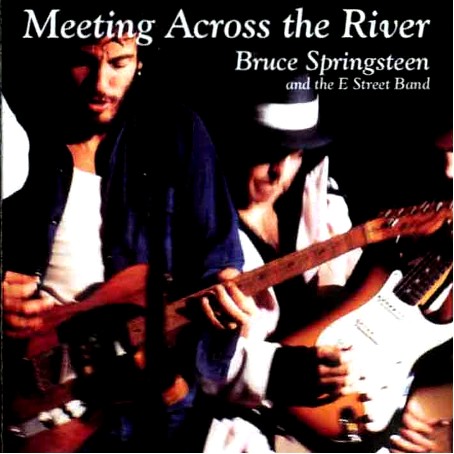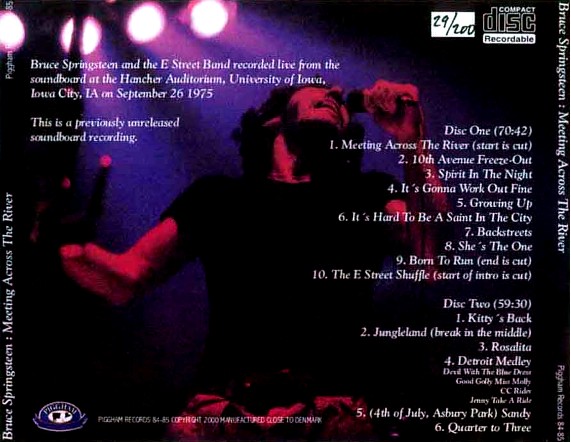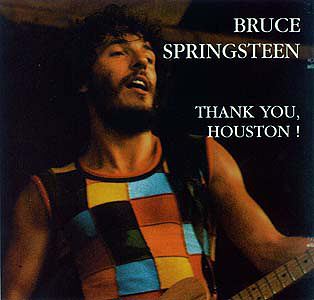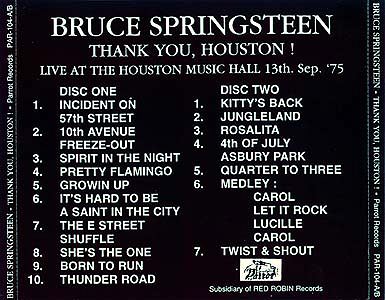Chissa se è di vostro interesse quest’ articolo dell’ ottobre 1975.
Buona lettura.
LITTLE EGYPT FROM ASBURY PARK
BRUCE SPRlNGSTEEN
D0N’T CRAWL ON
HIS BELLY NEITHER
DAVID MARSH
Bruce Springsteen sits cross-legged on his half-made bed, and surveys the scene.
Records are strewn across the room, singles mostly, intermixed with empty Pepsi
bottles, a motley of underwear, socks and jeans, half-read and half-written letters, an
assortment of tapes, and a copy of Richard Williams’ Out of His Head, the biography of Phil
Spector. The space is small, but Bruce and the two friends listening to Harold
Dorman’s “Mountain of Love” don’t mind. They’re listening for the final few bars of
“Mountain,” in which the drummer collapses and loses the beat—the song slows down
to a noticeably improper tempo, and the effect is nothing less than absurd.
Unfortunately Spnngsteen, unlubricated by anything more than the spirit of the
thing, is having trouble getting the turntable to spin consistently. (One of those weird
things with the green push button that lights up when you press it.) When he finally
does, it tu, rns out the record was warped. It is unplayable. Hysterically, Springsteen
sweeps it under the mass of accumulated debris.
“Here,” he says, “I’ll play ya something else.” He puts on a tape of he and the E Street
Barld at the Main Point in Philadelphia. Suddenly, out of the speakers booms his own
voice, carcking up at what he’s singing. (“That song has some of the best lines,” he
says shaking his head, “and some’of the dumbest.”) “Stan-din’ on a mountain iookin’ down
at the city, the way I feel t’nite is a dawgawn pity.” When the band comes in, the room
is charged. The playing and the singing is rough, even ragged, but it is alive, sparked
with the discovery of something vital in an old, trashy song. It has been a long time
since I heard anyone get this interested in rock and roll, even classic old rock and
roll. It has been a lot longer since anyone has gotten me so interested .
Song done, Springsteen snaps the tap,e recorder off. “There,” he says, with the
characteristic delinquent twinkle in his eye. “If that don’t get a club goin’, nothin’
will.”
Bruce Springsteen is determined to get’em going. The magic is that he doesn’t have to
be so determined to get himself going. Without being constantly “on,” like a
performer, Springsteen is constantly on, like someone who knows how good he is. He
is full of himself, confident without being arrogant, almost serene in his awareness of
what he is doing with his songs, his singing, his band. His music—and nothing gets in
the way of that. Unlike, say, Roxy Music, which makes very exciting music out of a
nearly desperate sense of boredom, Springsteen makes mesmerizing rock out of an
inner conviction that almost everything is interesting, even fascinating.
Take the three songs which, at this point, form the focus of the longawaited third
Springsteen album. “Born to Run” is almost a rock opera. But, rather than building his
concept piece around a derivative European anti-funk motif, Springsteen has built his
masterwork around a guitar line ripped straight from the heart of “Tel star.” It may
be too long (4:30) and too dense (layer upon layer of glockenspiel, voice, band,
strings) to be a hit, but it does capture the imagination with its evocation of
Springsteen’s usual characters—kids on the streets and ‘tween the sheets—and its
immortal catch-line: “Tramps hke us, baby we was born to run.”
Not that he couldn’t write something more classically oriented, if he needed to.
“Jungleland,” the ten minute opus which may very well serve as the title of the third
record, opens with 90 seconds of strings and percussion. But its influences are
classical in the way in which ’60s soul producers like Spector Holland-Dozier-Holland
and GambleHuff absorbed them, rather than in the way that pedants like those
unctuous Britons Yes and ELP have done. Its imagery is magnificient, exceeded only by
its music. Springsteen’s music is often strange because it has an almost traditional
sense of beauty, an inkling of the awe you can feel when, say, first falling in love or
finally discovering that the magic in the music is also in you. Which may also be first
falling in love.
“She’s the One,” on the other hand is pure sex, with a Bo Diddley beat that’s nothing
short of scary. Shorter, and less complicated than the other two, it could be the one.
(The Hollies’ “Sandy” might’ve beat him to it. As Springsteen fans know only too well
the Hollies’ version has almost nothing in common with Bruce’s. But then, what did
the Byrds’ “Mr. Tambourine Man” share with Dylan’s?)
All of this makes Bruce Springsteen just about what he thinks he is, or at least, hopes
to become: the Complete Rock and Roller. Few in rock and roll have attempted so
much. None of the ’50s rock and rollers were so ambitious—Elvis could have achieved
everything, even intellectual and production brilliance, without drawing a heavy
breath, if he had that ambition—and Bob Dylan never had the patience to, for
instance, make interestingly constructed records. The Beatles had the production
genius, with Martin and Spector and one suspects, without them, but they never
really had to tackle it on stage. In any case, like the Stones, their magic was more
collective than individual as subsequent events have shown. The Stones themselves
couldn’t be everything, because the scope of the group deliberately cannot contain
some of Springsteen’s farthest fetched (and I believe, most successful) ideas. For
instance, it’s hard to imagine Jagger coming out to sing a ballad as his first song, let
alone a ballad sung only against.violin accompaniment. Todd Rundgren had the idea,
and the scope, but—one suspects—not quite the guts or talent or sheer keening
madness to to go out and DO it, as a rock and roller. So he retired to the academy of
his own electronic idiosyncrasy.
And Rundgren’s myth was always internal. Because he spent so much time in the
cloister of the studio, word had to spread the hard way, by those who shelled out for
his records. Certainly nothing to compare with Springsteen’s full-blown stage show,
which lately encompasses such tricks as the new introduction to the slowed down “E
Street Shuffle:” Springsteen recounts walking down an Asbury avenue . Iate one dark
night, and seeing a giant black man at the corner. “I took the money out of my
pockets and threw it on the ground. I took my jacket and threw it on the ground,” he
says, standing in the glare of a single spotlight. ‘Then he put out his hand”—the enor–
mous black palm of gargantuan, spooky saxophonist Clarence Clemmons suddenly
juts into the glare and Springsteen whispers: “SPARKS fly on E Street.” It is a truly
unforgettable moment, taking on a racial fear at the same time that it devastates it
into an almost trivial joke. (And works better because Springsteen’s music so fully
encompasses soul influences.)
So it goes with a number of oneliners. moments (“Brace yourselves,” he shouted at
the beginning of the final chorus of “Quarter to Three,” his third encore one night.
You had to be there to discover how necessary it was to do that), even songs. I’ve
only seen him do Then I Kissed Her,” a remake of the gorgeous old Crystals’ song,
once, for instance, and I’ve been thirsting for it ever since. In this sense, it may be to
his advantage that he has no record. Not only does word-of-mouth have a chance to
spread more completely, but every instant is more special because it is irretrieveable.
That sense that he is special has begun to pervade even Springsteen’s semi-private
life. When he showed up at a party for label mates Blue Oyster Cult. Springsteen
completely dominated the room. So much so that Rod Stewart and a couple of the
Faces no slouches at scene-stealing themselves, were all but ignored when they made
a brief appearance. Yet he has yet to lose his innocence. Going to visit the Faces later
that night, at the ostentatiously elegant Plaza Hotel, Springsteen feigned
awe—although you wondered if it were entirely feigned—at the mirrored, plushly
carpeted lobby.
Fragments of a legend have begun to build. There are the stories about school—in
high school, the time when he was sent to first grade by a nun, and, continuing to act
the wise-ass, was put in the embarassing position of having the first grade nun
suggest to a smaller child: “Johnny, show Bruce how we treat people who. act like
that down here.” Johnny slapped Springsteen’s face. Or in college, the story of how
the student body petitioned the administration for his expulsion, “because I was just
too weird for ’em, I guess.” The newa that his father was a bus driver, which gives
added poignancy to ‘Does This Bus Stop at 82nd Street.” (Which begins, “Hey, bus
driver, keep the change.”) Aphorisms are not beyond him: On Led Zeppelin: “They’re
like a lot of those groups. Not only aren’t they doirlg anything new they don’t do the
old stuff so good, either.” On marriage: “I lived with someone once for two years. But
I decided that to be married, you had to write married music. And I’m not ready for
that. ” On the radio: “I don’t see how anyone listens to [the local progressive rock
station]. Everything’s so damn long. At least if you listen to [the local oldies station]
you know you’re gonna hit three out of five. And the stuff you don’t like doesn’t last
long.”
All of this goes only so far, of course. A record, a hit record, is a crucial necessity.
Sales of the first two albums are over 100,000 but that’s nothing in America. There
are still large areas of the country where Springsteen hasn’t played—even important
large cities such as Detroit have been left out—and though the word travels fast, and
frequently, articles like this ultimately seem like just the usual rhetoric without
something to back them up. As one
Californian put it, “I’ve heard enough. It’s like having everyone tell me I’m really
missing something by not seeing Egypt; When’s he going to come out here?”
Presuming he has the hit he deserves, Springsteen should be hitting most of America
over the rest of the year. After an abortive arena journey with Chicago, he is, he says,
reluctant to play large halls ever again. But he is one of the few rockers who would
have any idea of what to do—except blast—in a room the size of a hockey rink. (Mick
Jagger is about the only example who comes to mind, though Rod Stewart and Elvis
do pretty well now that I think of it.)
Suppose that he does hit the big time. Even, suppose that he really is, as the ads have
it, “rock and roll future.” What happens then?
Since I believe that.all of the above is true, and is going to happen, I have been at
some pains to try to figure it out. Certainly, not a new explosion, a la Beatles and
Elvis. Those phenomena were predicated upon an element of surprise, of catching an
audience unaware, that is simply no longer operative. Not with rock on nationwide TV
too many times a week. And not the kind of quiet, in-crowd build-up that propelled
Dylan into the national eye. What Springsteen is after—nothing less than
everything—has to be bigger than that, in mass terms though it obviously cannot
exceed Dyian in influence, his biggest achievement.
Springsteen’s impact may very well be most fully felt as a springboard, a device to get
people to do more than just pay attention. He can, potentially, polarize people in the
way that Elvis, the Beatles, the Stones, Dylan—all the really great ones—initially did.
(Already, some early Springsteen fans feel alienated by his ever more forceful
occupation with his soul influences.) The key to the success of those four is that as
many hated them as loved them—but everyone had to take a position. God knows
who he’ll drag into the spotlight with him—it might have been the N.Y. Dolls, whose
passion for soul oldies was equal to his or Loudon Wainwright, whose cool, humorous
vision parallels Bruce’s in a more adult (sort of) way—but that ought to be something
like what will happen. Sort of the way Carl Perkins Jerry Lee Lewis and the other
rockabilly crazies followed Elvis.
He’s smart though . He said it all, one night. introducing “Wear My Ring Around Your
Neck,” the Presley oldie. “There have been contenders. There have been pretenders.
But there is still only one King.”
But no king reigns forever.
http://feeds.feedburner.com/Tsitalia











